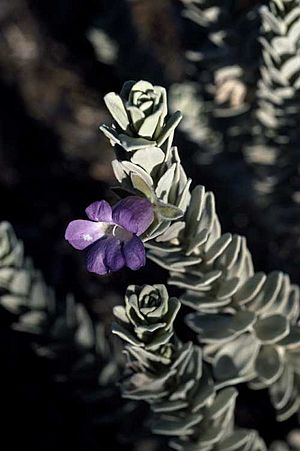Eremophila rhegos
Quick facts for kids Eremophila rhegos |
|
|---|---|
 |
|
| Conservation status | |
| Scientific classification | |
| Genus: |
Eremophila (plant)
|
| Species: |
rhegos
|
Eremophila rhegos is a type of flowering plant. It belongs to the figwort family, which is called Scrophulariaceae. This plant is special because it is found only in Western Australia. It grows as an upright shrub with fuzzy leaves and branches. Its flowers can be blue, mauve, purple, or white.
Contents
About the Eremophila rhegos Plant
Eremophila rhegos is a shrub with many branches. It can grow to be about 0.8 to 1.5 meters (2.6 to 4.9 feet) tall. Its branches and leaves are covered in thick, greyish-white hairs, making them feel very soft. The branches are also rough because of old leaf bases that stay on them.
The leaves grow close together at the ends of the branches. They are thick and shaped like an oval or a spear. Most leaves are about 16 to 24 millimeters (0.6 to 0.9 inches) long and 4.5 to 9 millimeters (0.2 to 0.4 inches) wide. They also have a clear middle vein.
Flowers and Fruits
The flowers of Eremophila rhegos grow one by one where the leaves meet the stem. They sit on fuzzy stalks that are about 4 to 6 millimeters (0.16 to 0.24 inches) long. Each flower has five spear-shaped, very hairy sepals. Sepals are like small leaves that protect the flower bud. These sepals are about 11 to 20 millimeters (0.4 to 0.8 inches) long.
The petals are joined together at the bottom to form a tube. This tube is about 20 to 35 millimeters (0.8 to 1.4 inches) long. The outside of the flower tube can be deep purple, blue, light lilac, or white. Inside, it is white with purple spots. The petals are smooth, except for some hairs around their edges. The inside of the tube is also full of long, soft hairs.
Inside the petal tube, there are four stamens. These are the parts of the flower that make pollen. They are completely hidden inside the tube. Eremophila rhegos flowers usually bloom from August to September. After the flowers, the plant produces oval-shaped fruits. These fruits are about 8.5 millimeters (0.33 inches) long.
Plant Naming and Discovery
This plant was officially described for the first time in 2007. It was named by a scientist called Robert Chinnock. His description was published in a book about Eremophila plants.
The second part of the plant's scientific name, rhegos, comes from an Ancient Greek word. This word means "rug" or "blanket." It was chosen because the plant has a thick, dense covering of hairs. This is especially noticeable on its branches and sepals.
Where Eremophila rhegos Lives
Eremophila rhegos grows in special types of soil. These soils are called "skeletal soils," which means they are thin and rocky. You can find this plant between Landor Station and Dairy Creek Station. These areas are located in the Gascoyne and Murchison regions of Western Australia.
Protecting the Plant
The Western Australian Government's Department of Parks and Wildlife has given Eremophila rhegos a special classification. It is listed as "Priority One." This means that the plant is known to exist in only a few places. Because of this, it might be at risk and needs protection.
Growing Eremophila rhegos in Gardens
This shrub is not often grown in home gardens. Because of this, we don't know a lot about what it needs to grow well. However, you can grow new plants from cuttings. Cuttings are small pieces of the plant that can grow roots. You can also grow it by grafting it onto a Myoporum rootstock. Grafting means joining a piece of Eremophila rhegos onto the root system of another plant.
This plant likes to grow in full sun. It also needs soil that drains water well. Eremophila rhegos can handle dry conditions, so it doesn't need a lot of water. It can also survive light frosts.


